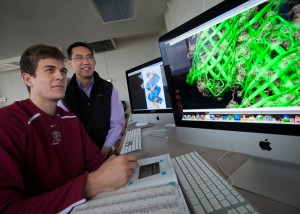
DNA research of genetic data
Eric Ho is employing the latest in DNA sequencing technology to uncover more effective treatments for Lyme disease and breast cancer.
Lafayette’s first computational biologist, Ho not only shares his research while teaching classes in biomedical science, he also enables students to take an active part in his cutting-edge work using Next Generation Sequencing (NGS), where a single test can potentially identify thousands—even millions—of genetic variants carried by a single individual.
“Today’s biology is an interdisciplinary science in which mathematics, physics, and computer science are highly relevant to major biological discoveries in recent decades, such as the sequencing of the human genome,” says Ho, assistant professor of biology.
 He’s been working with students on two NGS-related projects that have the potential to provide a more precise picture of the mutation profile of cancer tissue and the genetic variations of the bacterial strains that cause Lyme disease, the most common tickborne disease in North America. Ho’s research is particularly relevant in Pennsylvania, which has one of the highest rates of infection in the country.
He’s been working with students on two NGS-related projects that have the potential to provide a more precise picture of the mutation profile of cancer tissue and the genetic variations of the bacterial strains that cause Lyme disease, the most common tickborne disease in North America. Ho’s research is particularly relevant in Pennsylvania, which has one of the highest rates of infection in the country.
Maureen Carey ’14 partnered with Ho to study the molecular pathways affected by Lyme disease infection in mice. She also collaborated with biology professor Robert Kurt on data collection before she and Ho crunched the numbers using computational and statistical methods. A biology graduate, Carey is now pursuing a Ph.D. in infectious diseases at the University of Virginia.
Richard Tillquist ’14 assisted Ho last year in building a software simulator to study DNA sequencing technologies within parameters such as error rates and genome composition. They presented their work at the 90th annual meeting of the Pennsylvania Academy of Science and the Great Lakes Bioinformatics Conference. Tillquist, a computer science and mathematics graduate, is pursuing a Ph.D. in quantitative biology at the University of Colorado, Boulder.
Ho also worked with electrical and computer engineering major Gregory Flynn ’17 (Surrey, United Kingdom) over the summer to build a website that hosts genomic information on the crop-devastating begomovirus. Flynn helped build the website from scratch as the first centralized resource for researchers studying the virus.
“My goal is for students to learn how to formulate solutions outside the box, to learn where to find relevant information and how to acquire necessary skills fast,” says Ho. “It is extremely important for today’s education as the knowledge advances exponentially.”
Lyme Disease
 About 300,000 new cases of Lyme disease are diagnosed in the U.S. each year with the majority of confirmed reports coming from the Northeast, Mid-Atlantic and Upper Midwest regions, according to the Center for Disease Control.
About 300,000 new cases of Lyme disease are diagnosed in the U.S. each year with the majority of confirmed reports coming from the Northeast, Mid-Atlantic and Upper Midwest regions, according to the Center for Disease Control.
The disease is transmitted via deer ticks and can cause fever, headache, fatigue, and a skin rash that looks like a bulls-eye. Caught in time, the disease can be treated with antibiotics, but between 10 to 20 percent of people develop chronic cases. “Even though the bacteria is eradicated, symptoms persist in some people,” says Eric Ho, assistant professor of biology, who is using DNA sequencing technology in mice to study why certain genes are still disturbed by the infection after the bacteria is gone. “We’re trying to understand more about certain triggers on genomes by looking at the different activity of different genes.”

 He’s been working with students on two NGS-related projects that have the potential to provide a more precise picture of the mutation profile of cancer tissue and the genetic variations of the bacterial strains that cause Lyme disease, the most common tickborne disease in North America. Ho’s research is particularly relevant in Pennsylvania, which has one of the highest rates of infection in the country.
He’s been working with students on two NGS-related projects that have the potential to provide a more precise picture of the mutation profile of cancer tissue and the genetic variations of the bacterial strains that cause Lyme disease, the most common tickborne disease in North America. Ho’s research is particularly relevant in Pennsylvania, which has one of the highest rates of infection in the country. About 300,000 new cases of Lyme disease are diagnosed in the U.S. each year with the majority of confirmed reports coming from the Northeast, Mid-Atlantic and Upper Midwest regions, according to the Center for Disease Control.
About 300,000 new cases of Lyme disease are diagnosed in the U.S. each year with the majority of confirmed reports coming from the Northeast, Mid-Atlantic and Upper Midwest regions, according to the Center for Disease Control.